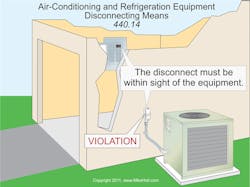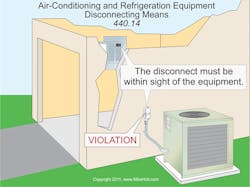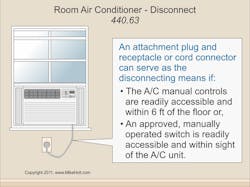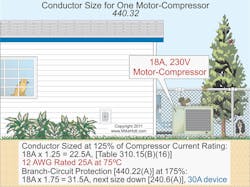Motors for air conditioning and refrigeration equipment are special-purpose motors called “hermetic,” meaning they’re sealed. They’re sealed because they’re in the same housing as the compressor and are operating in refrigerant. Consequently, their cooling and other characteristics differ from those of non-hermetic motors.
For these motors, Art. 440 supplements or amends the rules in Art. 430 and other Articles in the NEC. Household refrigerators and freezers, drinking water coolers, and beverage-dispensing machines are appliances, so their installation must also comply with Art. 422 for appliances [440.3(C)].
Ampacity and rating
The manufacturers of hermetic systems supply the correct protection, conductor sizing, and other information on the equipment nameplate. Use this information when wiring an air conditioner or other hermetic motor equipment.
Article 440 provides details for sizing branch circuit overcurrent protective devices (OCPDs), branch circuit conductors, and motor overload protection in Parts III, IV, and VI, respectively (Part V provides requirements for the controllers). Understanding those requirements can help avoid confusion, so we’ll look at those shortly. You’ll find the general requirements for sizing conductors and OCPDs in 440.4 through 440.6.
If you have multiple motors and/or other loads on the branch circuit, you must run through the same calculations you’d do if these were regular motors [430.24]. In this case, consider the highest-rated (largest) motor to be the one with the highest rated-load current [440.7].
Size feeder conductors and OCPDs per Art. 430 Part II and Part V, respectively. If a feeder supplies a hermetic motor directly, treat it as a branch circuit in regard to Art. 440.
Disconnecting means
For a hermetic refrigerant motor compressor, the ampere rating must be at least 115% of the nameplate rated-load
current or branch circuit selection current (whichever is greater) [440.12(A)(1)].
An attachment plug and receptacle can serve as the disconnecting means for cord-connected room air conditioners, household refrigerators and freezers, drinking water coolers, and beverage dispensers [440.13].
You can mount the disconnecting means on or within the air-conditioning equipment, but you can’t locate it on panels designed to allow access to the equipment — or where it will obscure the equipment nameplate.
Locate the disconnect within sight of and readily accessible from the equipment [440.14] (Fig. 1). Per Art. 100 “within sight” means it’s visible and not more than 50 ft away. Article 440 provides two exceptions:
Exception 1: You don’t need a disconnecting means within sight from the equipment if the:
• Disconnecting means can be individually locked in the open position.
• Equipment is essential to an industrial process in a facility that has written safety procedures.
• Conditions of maintenance and supervision ensure only qualified persons service the equipment.
The provision for locking or adding a lock to the disconnecting means must be on the switch or circuit breaker, and it must remain in place whether the lock is installed or not.
Exception 2: An accessible attachment plug and receptacle can serve as the disconnecting means for the equipment in 440.13, such as a household refrigerator, freezer, or beverage disperser. The receptacle for the attachment plug doesn’t have to be readily accessible.
An attachment plug and receptacle or cord connector can serve as the disconnecting means for a room air conditioner [440. 13, 440.63] (Fig. 2). However, this is true only if the manual controls on the room air conditioner are readily accessible and within 6 ft of the floor, or a readily accessible disconnecting means (e.g., that cord connector) is within sight from the room air conditioner. You can’t, for example, run the cord through a sheet of plywood and plug it in on the other side.
A flexible cord that supplies a room air conditioner can’t be longer than:
• 10 ft for 120V units.
• 6 ft for 208V or 240V units [440.64].
You must provide single-phase, cord-and-plug-connected room air conditioners with a factory-installed leakage current detector or with an AFCI [440.65].
Branch circuit overcurrent and ground fault protection
The branch circuit conductors, control equipment, and circuits supplying hermetic refrigerant motor compressors must be protected against short circuits and ground faults. The requirements for this are in 440.22, which supplements or amends the requirements of Art. 240.
Let’s look at single motor compressors. Notice where the hyphen is; the motor is actually built into the compressor. For these, you initially size the short circuit and ground fault OCPD to no more than 175% of the motor compressor current rating.
If you reached the 175% threshold but the OCPD can’t carry the starting current of the motor compressor, you can use the next size larger OCPD. However, this OCPD can’t exceed 225% of the motor compressor current rating.
What if you size it at 225%, and it still won’t carry the starting current? Then you have some troubleshooting to do. Common causes include excessive voltage drop, refrigerant problems, and controller problems. Investigate these, and you’ll probably find why that OCPD can’t handle the starting current.
Let’s work a sample problem. What size 75°C conductor and protection do you need for a 24A motor compressor connected to a 240V circuit? We solve this problem with this two-step process:
Step 1: Determine the branch circuit conductor [Table 310.15(B)(16) and 440.32]:
24A × 1.25 = 30A, 10 AWG, rated 30A at 75°C [Table 310.15(B)(16)]
Step 2: Determine the branch circuit protection [240.6(A) and 440.22(A)]:
24A × 1.75 = 42A, next size down = 40A
Suppose the 40A short circuit and ground fault OCPD can’t carry the starting current, so you decide to size the OCPD up to 225% of the equipment load current rating. That works out as: 24A × 2.25 = 54A, next size down 50A.
If the equipment contains more than one hermetic refrigerant motor compressor, or a hermetic refrigerant motor compressor and other loads, the equipment must have a visible nameplate containing the maximum rating of the branch circuit short circuit and ground fault OCPD.
Size the branch circuit conductors at 125% of the largest motor compressor current, plus the sum of the rated-load currents of the other compressors [440.33]. This is identical to how you do it for other types of motors [430.24] except Art. 440 wants you to use the largest motor compressor current as your “largest motor.”
Sizing conductors
Branch circuit conductors to a single motor compressor must have an ampacity not less than 125% of the motor compressor rated-load current or the branch circuit selection current — whichever is greater [440.32].
Sizing these is a straightforward table look-up of the amps after you multiply by 125%. Let’s combine that with OCPD sizing in a sample problem.
What size 75°C conductor and overcurrent device do you need for an 18A motor compressor (Fig. 3)?
Solve it with this two-step process:
Step 1: Determine the branch circuit conductor [Table 310.15(B)(16) and 440.32]:
18A × 1.25 = 22.50A, 12 AWG, rated 25A at 75°C [Table 310.15(B)(16)]
Step 2: Determine the branch-circuit protection [240.6(A) and 440.22(A)]:
18A × 1.75 = 31.50A, next size down = 30A
Suppose the 30A OCPD can’t carry the starting current, so, you decide to size the OCPD up to 225% of the equipment load current rating. That works out as:
18A × 2.25 = 40.50A, next size down 40A.
Note: You can use a 30A or 40A OCPD to protect a 12 AWG conductor for an air-conditioning circuit. See 240.4(G).
Room air conditioners
Room air conditioners aren’t just for residential use. They are also used for commercial and industrial applications like guard shacks, construction trailers, chemical storage sheds, and industrial control panels.
The requirements of Art. 440 Part VII apply to a cord- and plug-connected room air conditioner of the window or in-wall type that incorporates a hermetic refrigerant motor compressor rated not over 40A, 250V, single-phase [440.60].
The branch circuit conductors for a cord and plug-connected room air conditioner must have an ampacity not less than 125% of the rated-load current [440.32].
If the room air conditioner is the only load on a circuit, the marked rating of the air conditioner can’t exceed 80% of the rating of the circuit OCPD [440.62(B)].
The total rating of a cord- and plug-connected room air conditioner must not exceed 50% of the rating of a branch circuit where lighting outlets, other appliances, or general-use receptacles are also supplied [440.62(C)].
Final tip
Not every motor used in a refrigeration system is a hermetic motor. For example, a large refrigeration unit may have a motor-driven carousel, exhaust fan, and air-filtration blower. Now you have three motors plus the hermetic one. Apply Art. 440 only to motors integrated into a coolant compressor.
About the Author

Mike Holt
Mike Holt is the owner of Mike Holt Enterprises (www.MikeHolt.com), one of the largest electrical publishers in the United States. He earned a master's degree in the Business Administration Program (MBA) from the University of Miami. He earned his reputation as a National Electrical Code (NEC) expert by working his way up through the electrical trade. Formally a construction editor for two different trade publications, Mike started his career as an apprentice electrician and eventually became a master electrician, an electrical inspector, a contractor, and an educator. Mike has taught more than 1,000 classes on 30 different electrical-related subjects — ranging from alarm installations to exam preparation and voltage drop calculations. He continues to produce seminars, videos, books, and online training for the trade as well as contribute monthly Code content to EC&M magazine.



